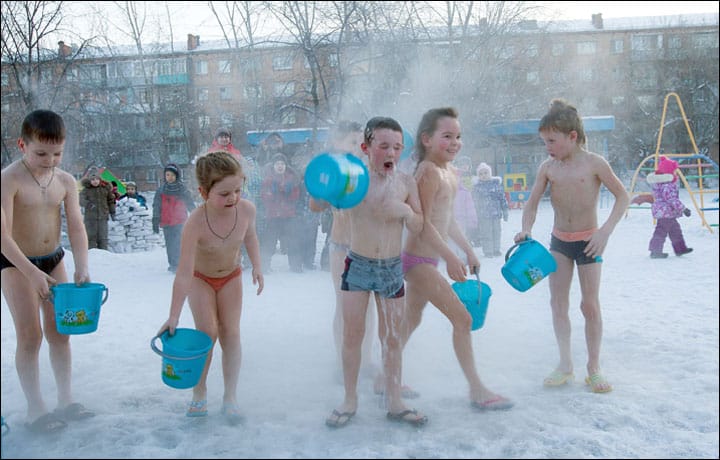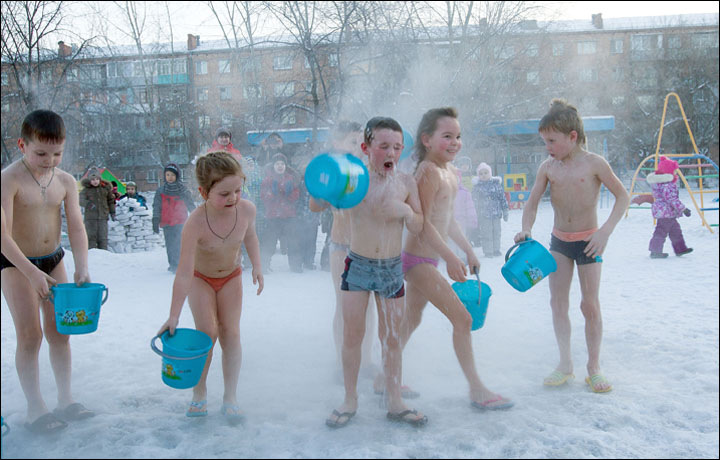A daily bucket of icy water poured over the head ‘helps block winter illnesses, and makes children optimistic’.
‘The children who do have the ice showers are also are more sensible, balanced – and optimistic.’ Picture: Vera Salnitskaya
For pre-school teacher and swimming coach Oksana Kabotko, 41, there is no doubt that a pail of ice cold water is beneficial to her children ranging in age between three and six. This is part of the curriculum at Sibiryachok – or Little Siberian – state kindergarten number 317 in Krasnoyarsk, although it is not compulsory.
‘Children have the ice cold shower if it’s no colder than minus 25C,’ she explained. ‘But this year we did it at minus 30C, on the Epiphany Day, along with their parents.’
Traditionally, Russians bathe in ice pools to mark this important Christian day, regardless of the winter temperature, marking the baptism of Jesus in the River Jordan, as our story here shows. Temperatures go up and down in the Krasnoyarsk winter: today was mild, only minus 10C.
Oksana insisted that far from being harmful to the children, this ice bucket treatment does them good in myriad ways, a ‘medical fact’ backed by many doctors in Siberia.

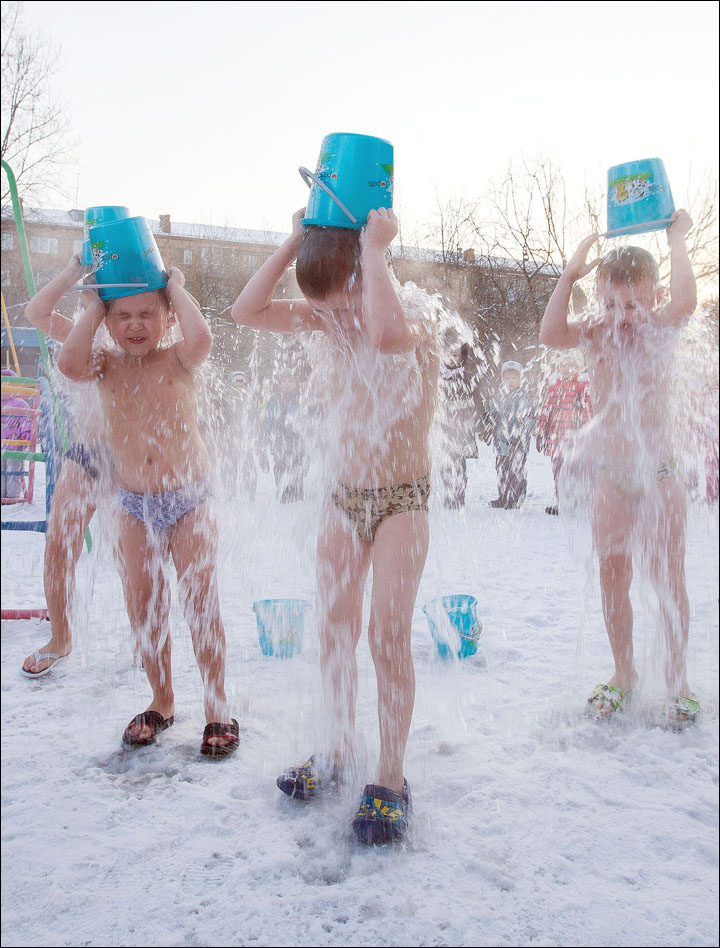

‘But just imagine, you need to do it every morning, you require the willpower to do that.’ Pictures: Vera Salnitskaya
‘Of course, there are some contradictions, and it’s all very personal, but it is checked by a pediatrician,’ she said, explaining her own observations about children who do – and don’t – take the ice bucket ‘treatment’.
Still, she heard that the Japanese at some pointed declined to use pictures of these daily cold douches – believing them to be cruel for the children: to her, the truth is the opposite.
‘Those children who have ice cold shower daily, not once every two weeks, come regularly to the kindergarten,’ she said. ‘Of course, they can come down with some illness during the winter but it passes more quickly, after a few days at home. Those who don’t take an ice shower may spend up to two weeks at home recovering.
‘The children who do have the ice showers are also are more sensible, balanced – and optimistic. They are better organised. But just imagine, you need to do it every morning, you require the willpower to do that. We don’t force anyone. There are also some children who don’t go to our kindergarten but join us just for the shower.’
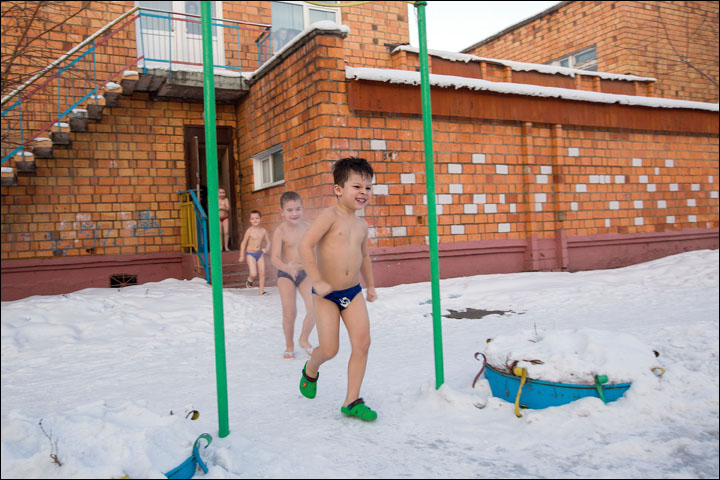
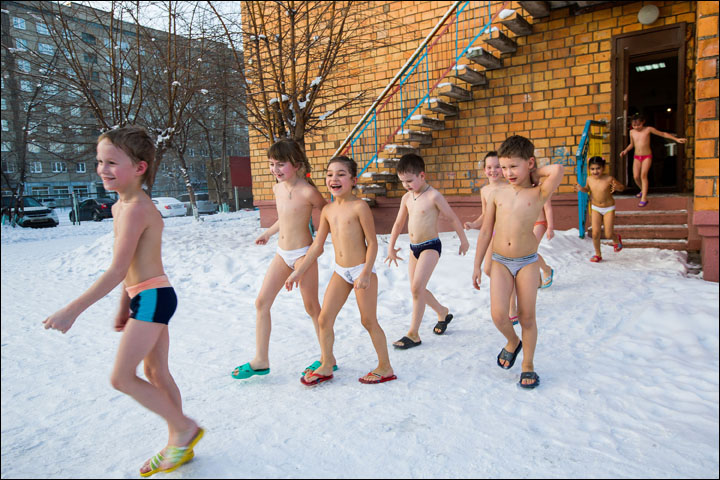
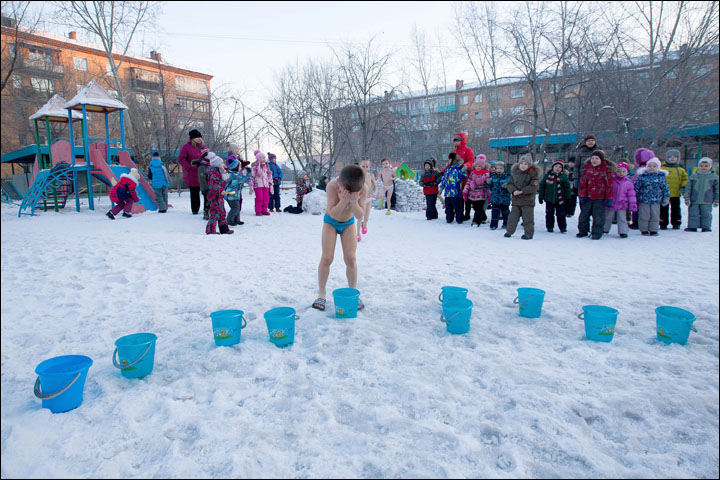
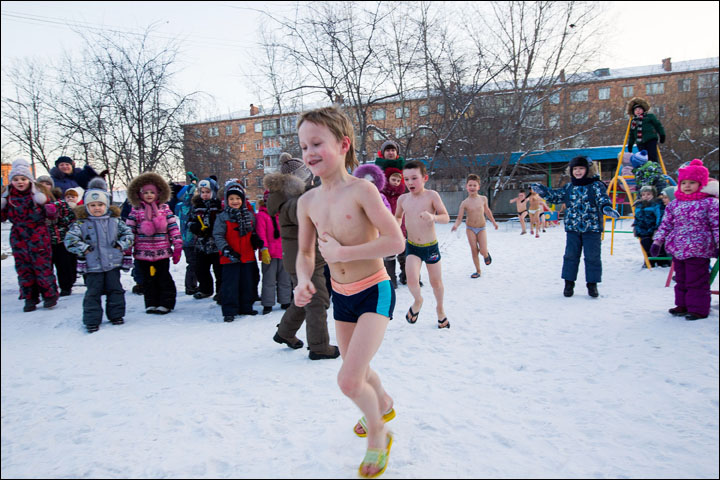
‘Before having ice cold showers, children spend some time in the banya (steam sauna), having a warm-up.’ Pictures: Vera Salnitskaya
Former pupils join in the bracing 8am treatment because once it is habit, you feel you need it.
They go in groups, the youngest first, those in the middle, then the older children, dressed in either swim wear or underclothes. ‘Those who are regulars can’t live without it, it becomes an essential part of their lifestyle,’ said Oksana. ‘Before having ice cold showers, children spend some time in the banya (steam sauna), having a warm-up.’
Kindergarten staff prepare the ice buckets outside, all lined up in the snow. ‘Children run from the banya. Some wear flip flops, others run barefoot,’ she said. ‘Sometimes they run around outdoors a little, just 20 metres in the fresh air. First they wash their faces and then shower. Some pour water on their head, others – on their chest.
‘The children really enjoy their showers. They line up to tell how much they like it. The younger kids run faster and scream louder. The older ones walk as if they are on a red carpet as if it’s not cold. Some don’t shower outdoors, and instead do it indoors.’
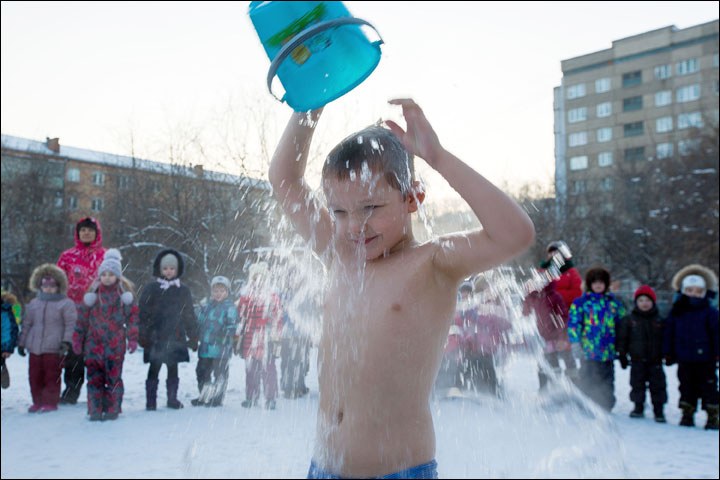
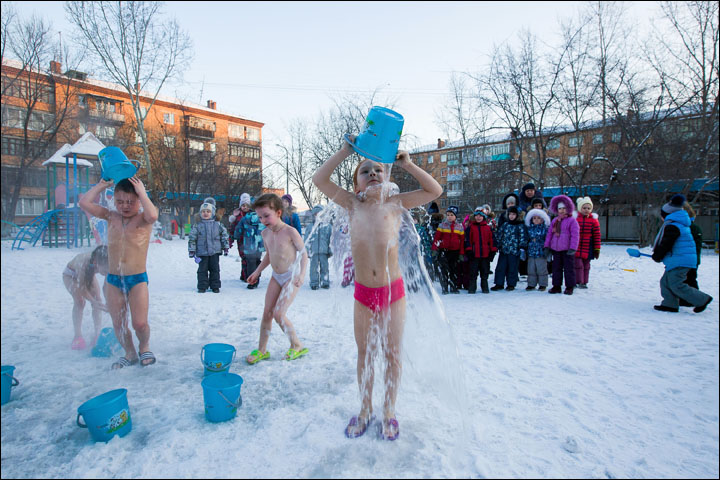
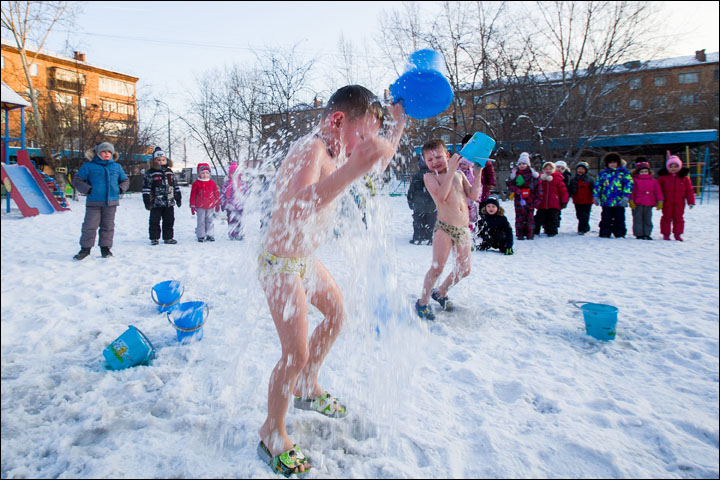
A daily ice bucket in Krasnoyarsk kindergarten. Pictures: Vera Salnitskaya
Oksana said: ‘At the beginning of the academic year, we talk to parents about their children having an ice cold shower in the street (meaning outside). They need to sign approval papers.
‘In the 1990s such programmes were quite popular – but we are now the only kindergarten which still has a ‘street shower’, although others have indoor programmes.
‘Initially, in 1998, our staff took the ice cold water shower, then they started doing it with their own children. Later they invited parents to join in. Parents of some of the children attending our kindergarten came here in their childhood.’
There are some 150 children in her kindergarten. ‘Normally, when we start in September, there are a lot of children, around 70, taking part,’ she said.
‘By winter half of them drop out because it is actually quite challenging: you need to do it every day, you need to be in the right mood. And actually you need to do it regardless of your mood.’
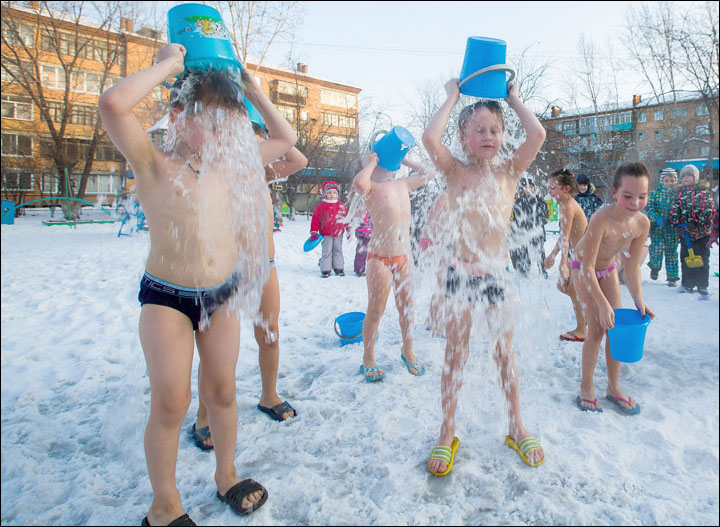
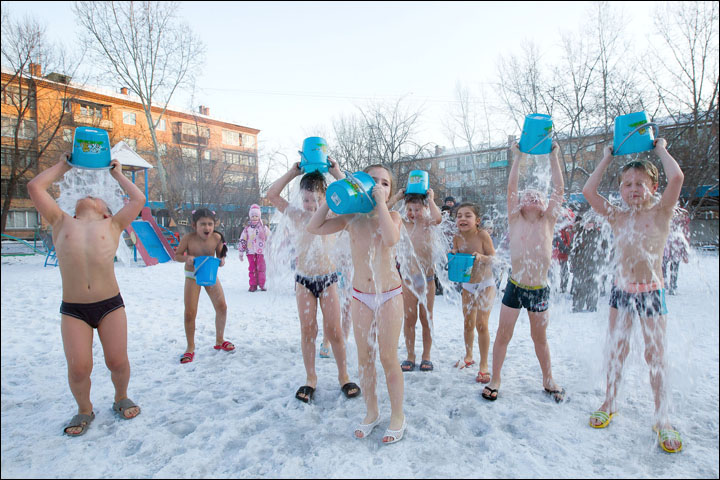
‘I must say it is very refreshing and, more important, it helps to relieve stress very well.’ Pictures: Vera Salnitskaya
The youngest children – aged three – will only go outside for this ritual in March once the snow starts melting. ‘Children aged four or five have the ice cold shower from autumn – and through the winter,’ she said.
‘When we begin the programme, the water is normally about 30C and then we gradually decrease it, depending on the outdoor temperature, and the way kids feel.’
In midwinter, the water is as cold as it can be. Afterwards the children dry off, dress, and get back to their classes. ‘It’s not cold, I feel warm,’ said one little boy, Sergei. ‘It’s exciting,’ said Alina.
Oksana said: ‘When we first started, there were very curious people hanging over the fence literally to see kids showering with the cold water. Now we’re part of landscape.’
Proponents of such cold cures cite a 1997 study in Sochi by Dr V Kharitonov when blood samples of students was tested before and after they had poured buckets of cold water over their heads. This found ‘statistically significant’ changes in a majority of indicators regarding the cellular immune system.
Another advocate of this treatment is Olesya Osintseva, a veteran kindergarten director in the city of Barnaul.

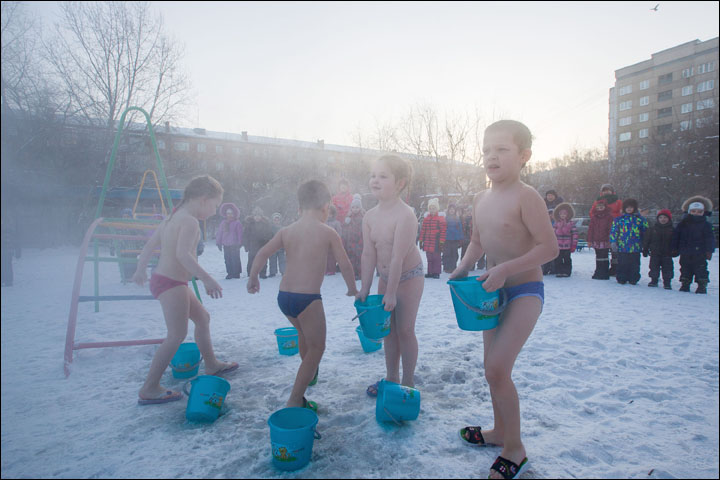
‘Children aged four or five have the ice cold shower from autumn – and through the winter.’ Pictures: Vera Salnitskaya
When The Siberian Times talked to her several years ago she explained that a former problem of winter illnesses among children was cut dramatically when the ice bucket procedures began.
‘They were catching influenzas, and there were moments when half of the children attending the kindergarten were unwell,’ she said. ‘It was obvious that something needed to be done to make them grow stronger and be more resilient against viruses. This is how we came to the idea of boosting their immunity up by doing this exercise with buckets of chilly water outside in the cold.
‘We tested it on ourselves and our own children first, when both adults and children were first going out and splashing their feet with water, and in some months pouring cold water bucket over our heads.
‘What six months of these water exercises showed was an immediately stronger resistance to illnesses. Our kids were now able to go to the kindergarten and even if someone had infection, they were no longer catching it.

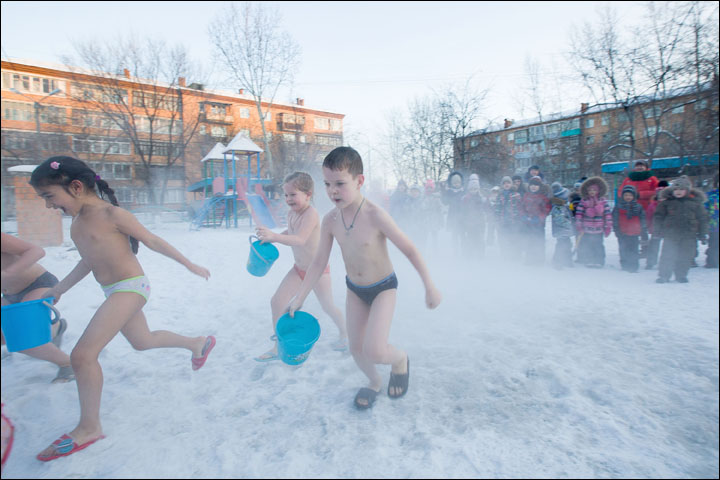
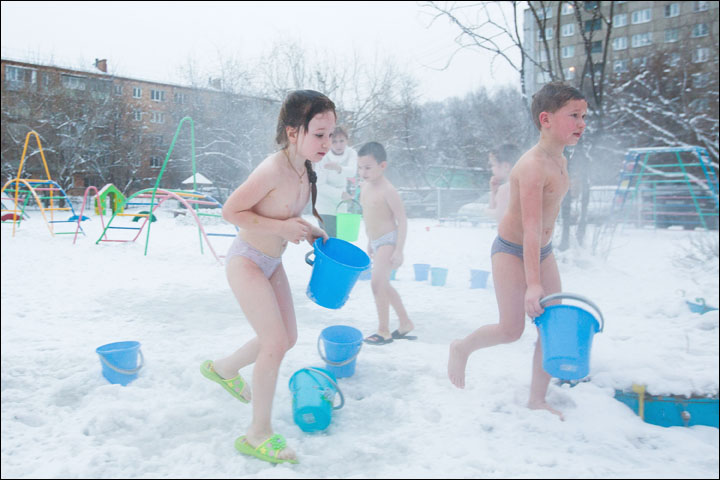
‘Our doctor confirms that children in groups that practice dousing get through the flu season a lot more easily.’ Pictures: Vera Salnitskaya
‘Then we made the next step and spoke about our experience to other parents. Some got nervous about the idea of their kids showering themselves with cold water in the middle of winter; others said they were keen to try.
‘Now the kindergarten runs a separate group of children where all of them start with the cold water bucket from the tender age of two. I am completely sure: these children are noticeably healthier.’
Teacher Lyubov Daniltsova added: ‘Perhaps people will not believe us, but facts are hard to argue with. Our doctor confirms that children in groups that practice dousing get through the flu season a lot more easily, and generally the statistics show there are 95% of healthy children in the ‘wet’ group, compared to 75% among the others.’
By Olga Gertcyk and Vera Salitskaya

